#josephine nivison
Text
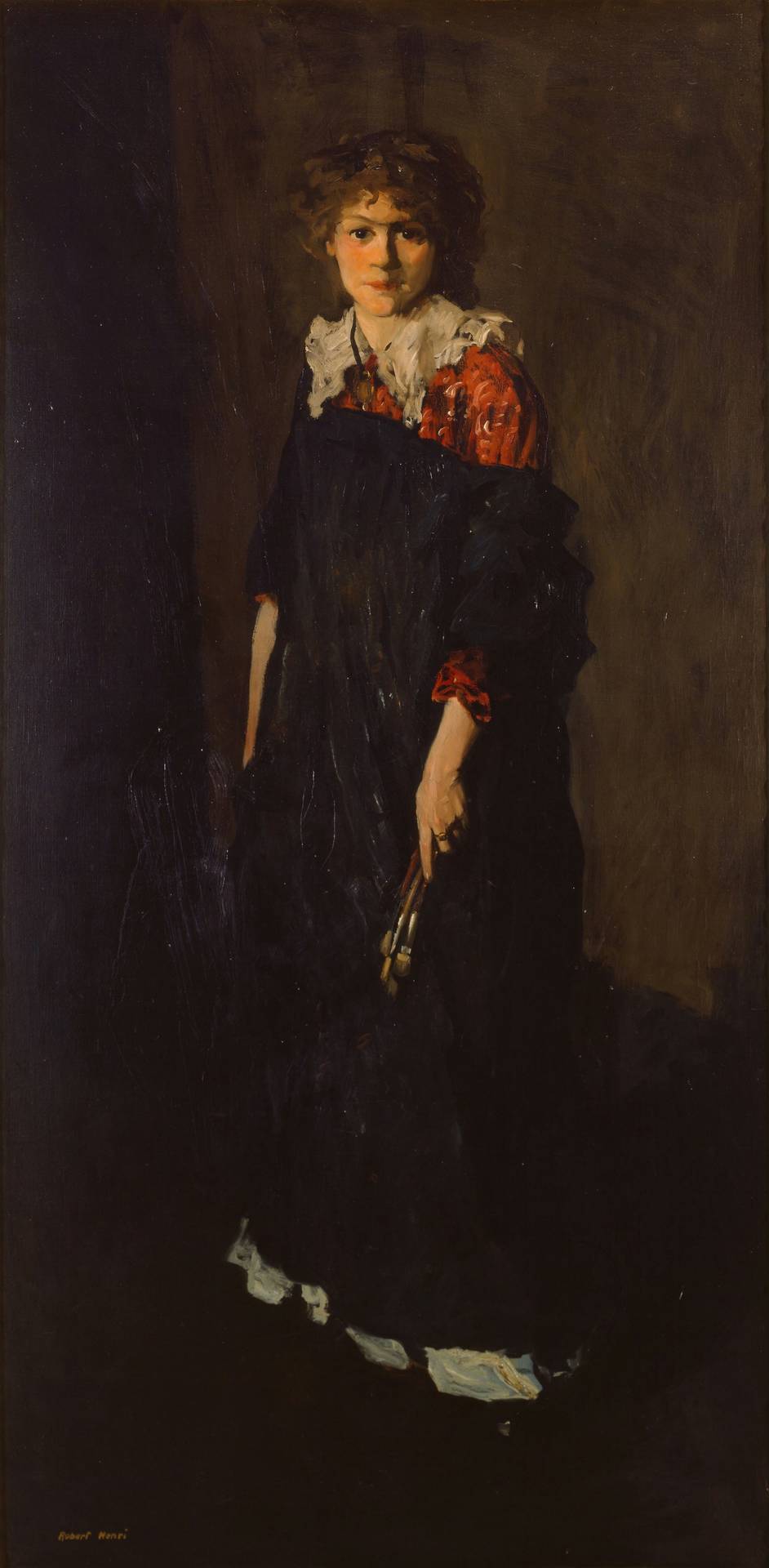
Robert Henri - The Art Student (Miss Josephine Nivison), 1906
33 notes
·
View notes
Text

The new episode of Crossroads of Rockland History is streaming now! It is available on all major podcast platforms, or listen at the link below.
(Please note that a 30-minute version of this interview aired on Monday, November 21, 2022 at 9:30AM on WRCR Radio 1700AM.)
2022 marks the 140th birthday of Edward Hopper. On this episode, we learned about about the events celebrating this extraordinary artist, who was born in Nyack, NY.
Kathie Bennewitz, executive director of the Edward Hopper House, joined host Clare Sheridan to discuss the new exhibition at Hopper House, "Edward Hopper‘s Boyhood on the Hudson River and Emerging Artistic Vision," on view now through March 26, 2023; a new documentary about Hopper, "Hopper, An American Love Story" that was screened on November 16, 2022, at Rivertown Film; and the Whitney Museum’s new exhibition "Edward Hopper’s New York."
***
About our guest: Kathleen Motes Bennewitz, executive director of the Edward Hopper House, has extensive experience with Connecticut museums and nonprofits and has won several awards, including the Connecticut League of History Organizations Award of Merit in 2019 and 2020 and the Leadership in History Award, the most prestigious national award given by the American Association of State and Local History (AASLH), in 2017. She holds degrees in art history from Princeton University and the University of Delaware. After curatorial positions at the Amon Carter Museum and Frederick R. Weisman Art Museum at the University of Minnesota, and in education at the Minneapolis Institute of Art, she served as director of exhibitions and programs at the Greenwich Historical Society (the historic site of the Cos Cob art colony) and Fairfield Museum and History Center. She has curated exhibits on American art and artists over her career and in Connecticut at the Lockwood-Matthews Mansion Museum, Norwalk Historical Society, Westport Historical Society, Westport Library, and Westport Public Art Collections. She and her husband, Scott, have twin adult daughters.
About the Hopper House exhibition: Curated by Carole Perry and Kathleen Motes Bennewitz, with Lynne Z. Bassett, this new exhibition, on view through March 26, 2023, showcases childhood drawings by the artist on loan from the Whitney Museum of American Art and works from private collections, including the Arthayer R. Sanborn Hopper Collection Trust, alongside Hopper’s school notebooks and artmaking materials and artworks by family members from the Museum’s Sanborn-Hopper Family Archive. Together, these objects provide a glimpse into Hopper’s early years, the influence of his boyhood proximity to the busy waterfront and commercial district of his hometown, and insights into his life at home and his family’s support of his developing talent and ambitions. www.edwardhopperhouse.org/hopper-boyhood.html
About the documentary screening: Phil Grabsky’s new documentary, Hopper: An American Love Story, was released in October 2022 to coincide with the Whitney Museum of American Art’s exhibition Edward Hopper’s New York and the Edward Hopper House Museum’s Edward Hopper’s Hudson River Boyhood and Emerging Artistic Vision. The acclaimed film explores the enigmatic personality behind the brush, taking a deep look into Hopper’s art, his life, and his relationships, and prominently features Nyack in its opening chapter. exhibitiononscreen.com/films/hopper/
Whitney Museum Exhibition: whitney.org/exhibitions/edward-hopper-new-york
#rockland history#local history#rocklandhistory#rockland county#nyshistory#orangetown#nyack#historic preservation#edward hopper#Josephine nivison#nys history
0 notes
Text
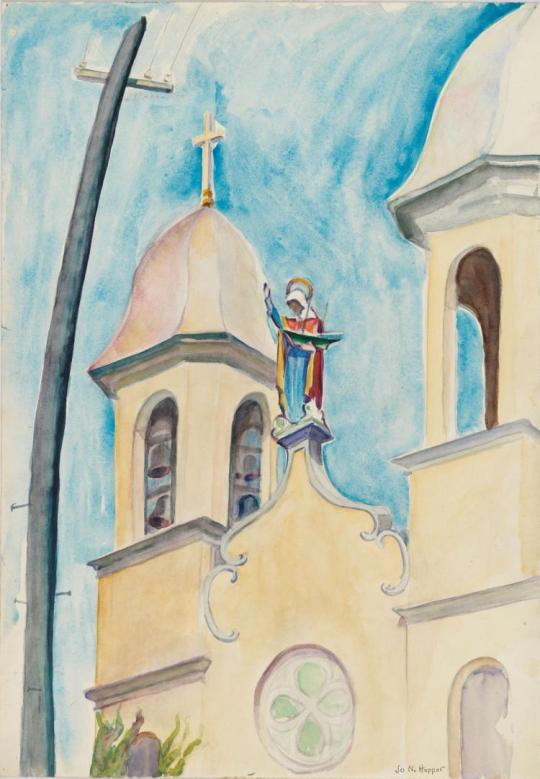
Josephine Nivison Hopper - Church Towers, Gloucester, 1923
29 notes
·
View notes
Text

Edward Hopper
Jo Painting
1936
Oil on canvas
#Edward Hopper#jo painting#Josephine Nivison Hopper#painting#whitney museum#portrait of an artist#Hopper’s New York
101 notes
·
View notes
Text

Visite au Musée.....à la découverte du grand peintre Edward Hopper
Edward Hopper est l'une des figures majeures du mouvement réaliste américain, avec des tableaux tels que House by the Railroad (1925) et Nighthawks (1942).
Né en 1882 dans l'État de New York, Edward Hopper intègre la prestigieuse New York School of Art après ses études secondaires. Il s'installe à New York en 1908 où il est engagé comme illustrateur pour des campagnes publicitaires.
Il se lasse rapidement de ce travail et expose des peintures pendant son temps libre. Vers 1915, il peint des scènes de la vie américaine et en 1920, il présente sa première exposition au Whitney Studio Club, qui remporte un grand succès. En 1924, il épouse Josephine Verstille Nivison.
Son style particulier, fait de formes simples et de couleurs plutôt sombres, joue sur les contrastes entre ombre et lumière. Hopper parvient à diversifier son approche réaliste, avec des paysages mis en scène, tantôt urbains, tantôt ruraux. Les personnages qu'il peint inspirent souvent une impression de solitude et d'exclusion. La plupart de ses peintures à l'huile reflètent un pays en pleine mutation économique et sociale. En 1945, Edward Hopper a été admis à l'Académie américaine des arts et des lettres. Il a reçu de nombreux prix et distinctions, dont le titre de docteur en beaux-arts de l'Art Institute of Chicago en 1955.

Hotel Room (Chambre d'hôtel) de Edward Hopper
"Hotel Room" est une peinture de l'artiste américain Edward Hopper, réalisée en 1931. Cette œuvre représente une chambre d'hôtel vide, avec une fenêtre ouverte laissant entrer la lumière du jour. On peut voir un lit de défait, une chaise et une table de nuit, ainsi qu'un miroir sur le mur. Le sol est recouvert de carreaux blancs et noirs et l'atmosphère générale est celle d'une chambre d'hôtel banale et anonyme.
Hopper a souvent peint des scènes urbaines et des bâtiments commerciaux, et "Hotel Room" est un exemple de son intérêt pour les espaces vides et solitaires. Il a été inspiré par les voyages qu'il a faits dans les années 1920 et 1930, où il a été frappé par l'anonymat et la solitude des hôtels. Il a également été influencé par les écrits de William Dean Howells, qui a décrit les hôtels comme des lieux de solitude et d'isolement.
La lumière joue également un rôle important dans cette peinture. La lumière du jour qui entre par la fenêtre donne à la chambre une atmosphère de transparence et de clarté, mais en même temps elle accentue la solitude de l'espace vide. Hopper a souvent utilisé la lumière pour créer une atmosphère particulière dans ses œuvres, et dans "Hotel Room", elle renforce l'idée de solitude et d'isolement. Cette peinture est considérée comme l'une des œuvres les plus importantes de Hopper en raison de son thème universel de solitude et d'isolement dans un espace public. Il a réussi à capturer l'essence de la vie moderne de manière poignante et à susciter des réflexions sur la nature humaine et sur les relations entre les individus et l'espace qui les entoure.
18 notes
·
View notes
Text
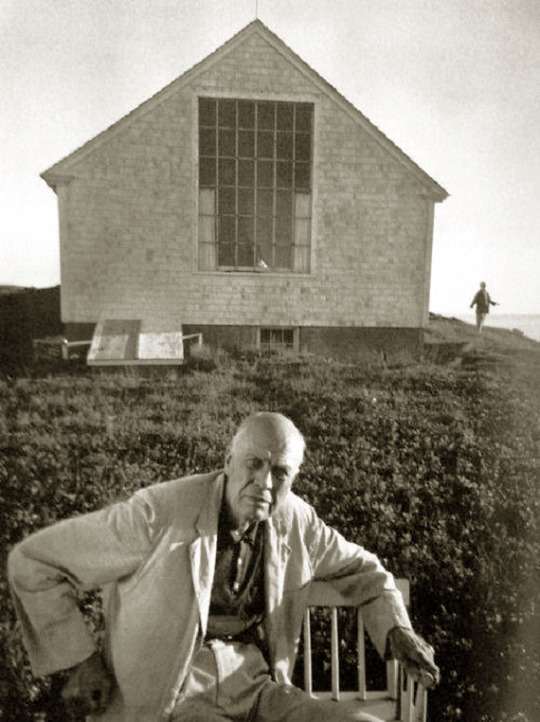
Hopper
Artista da solidão: Edward Hopper, precursor da Pop Art, ilustre aniversariante de 22 de julho – fotografado por Arnold Newman em 1960, tendo ao fundo Josephine Nivison, também artista plástica e esposa de Hopper.
Veja mais em:
Semióticas – Silêncio de Hopper
.
5 notes
·
View notes
Text
Per la Grande Arte al Cinema prodotta da Nexo digital, il 9 e 10 aprile 2024 è in arrivo un docufilm d’eccezione dedicato a Edward Hopper, pittore simbolo dell’arte americana.
0 notes
Text
1 note
·
View note
Text
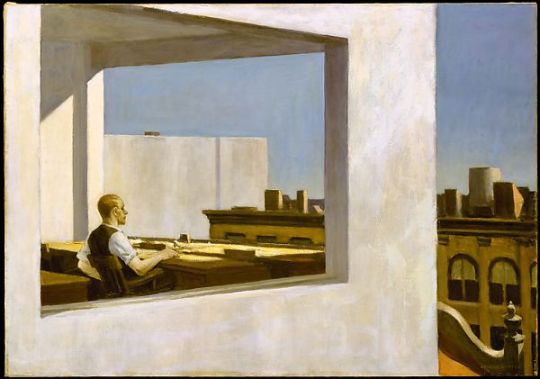
The Soft Sabbath
A piece on Edward Hopper
By Griffin Gibson
502-120-VA Visual Literacy And Culture
Pull the plug, Cut the cord, Disconnect. That is Edward Hopper. Born into a well off bourgeois family, by the age of five Hopper had a clear intuitive talent with art and was signing his work by 11. Throughout this time, his family was providing him with the materials and books to educate himself with. After highschool, Hopper went off to college for design and began freelance painting with moderate success. He went on to date and soon marry a former friend from college, Josephine Nivison, a very important person in his life. In that same year, with a couple decades of experience painting, he had his first breakthrough at a show his wife helped set up. For the next few decades, his work was a soft wave of success flowing across him. He had won. Everyone has an inner and outer story, and Hopper’s outer story was very boring in a sense. Pain is always on the inside. Hopper worked with a few different types of art. He was very adept with charcoal from a young age and was talented with watercolor, though a majority of his pieces were rendered and paved in oil paint. As a young adult in New York City, he fell in love with the concrete and tarmac around him and had a fascination for the scenery shown everywhere, sometimes with a few people shown in his work. In “Office in a small city” there's just one. Hopper has a tendency to depict people voyeuristically, he shows flawed people in the places he makes. They're never happy, never complete, they smothered in contemplation. You’d be lucky to see the average set of lips Hopper makes move 3 degrees from the last. In ‘Office in a Small City’, Hopper portrays an office worker in a solid yet sedated state, the man is completely relaxed leaning back, but he's aware. He can hear and see but he's melting into his chair and staring into his own head. Hopper paints and paints and paints different colours and people, but in the end, it's all him. “I think the American Scene painters caricatured America. I always wanted to do myself”.
The standout feature in ‘Office in a Small City’ would be the smoothness of it all, like a steam roller drove up the side of the buildings. That sort of texture is commonplace in Hopper's work. The space and form of the picture is another highlight, the paneless windows letting you into the lives of others. Hopper's buildings are made in a personified way. He has a usual spacing, a common feature being a hollow window set in front of and behind the focal figure, this being done in Office in a Small City as well. Your eyes pierce through the concrete being seeing its insides and outsides with the binoculars and vantage point Hopper made for you. There's an interesting use of color in the piece, as while the lighting and sky would make you think there's happiness involved, everything around the man is dry. It's a completely unromantic view of the time of day, showing the complexity of what's inside someone's cranium to be more important than simply the mood. In this painting, and many of his others, he transcends traditional melancholy and other gray emotions. He's able to represent loneliness even when surrounded by others or even a sense of unsatisfied boredom in his art. If we are to assume this is part of himself, does an apathetic reaction mean something? In the time he was living in, this grandiose level of infrastructure in metropolises was considered an achievement of man so im able to see this as Hopper in his studio, looking over his life's work, his success, though the satisfaction, the flag in the mountain, it eludes him. He's still relaxed, at this point in his life he would be 72 with a path of success paved behind him but this doesn't mean he's happy. The message is one of the human condition. I think this painting, and alot his work, is about people. In a concrete jungle it's easy to step on the insects. I think it's about the inner. Objectively, this painting is made up of a person and a building. Subjectively, both of those things are man. What you think are solid atoms melt back into the heart, not the brain. It's worth mentioning at this point that Hopper's marriage with Josephine Nivison did not have a happy ending. As time marched on they grew entangled with flaws, ending with resentment. Most of the women in Hopper's paintings were modeled after his wife because of her very strict demands. This later failed relationship put Hopper through a soft hardship. The kind you can't sleep through. The cultural impact of Hopper's work is immense. Though many of his pictures do not have any sort of readily clear message or political view, they've regardless been a massive inspiration for many artists. His ability to animate a landscape was something admired by many people, myself included. The colours he chooses to use are always thought out, much like the other aspects of his work and with his poetic depictions of people that are stuck in a workers world yet still resonate deeply with many despite the images’ context, it makes for something to be inspired by. Beyond even technical skill, sapped inspiration from many were yet derived from Hopper’s paintings because of their cultural significance in their depictions of jaded people molded through the world. Growing up in the start of the 20th century and late 19th century, Hopper was witness to the effects labor had on people and that time-period-specific experience more than bleeds through his art. I'd argue it's the metaphorical heart of what he paints, the core that builds all around it. As mentioned before, the framing of the piece is important, it shows us both a behind and frontal view of this man. We see how he sees the world. Another key factor would be that Hopper’s paintings rarely have an entry point that's not a window. Our only way into these peoples’ lives are through a hollow window, a peak, a skewed view through an honest one.
Hopper's work is extremely subjective. I've brought up many things that could have been represented, or were instead completely unrelated and are a wild guess. Yet that's the thing, I don't think there is a concrete message to Hopper’s concrete jungles, I think because he's always strived to paint himself, when you look at a piece of his, your eyes show you what you have inside. In that way, Hopper’s paintings are able to be seen by anyone and understood at least in some way, though I don't think they were meant for anyone, he made them for himself. I personally adore Hopper’s work, many of his paintings capture this sort of essence of being I can't seem to find anywhere else. When I look through the paneless hollow windows of Edward Hopper’s work, I always just end up seeing myself again. Pull the plug. Cut the cord. Disconnect. That is Edward Hopper.
Bibliography :
Nochlin, Linda. "Edward Hopper and the imagery of alienation." Art Journal 41.2 (1981): 136-141.
“Rather, Hopper, a realist, works with the rhetorical device of synecdoche, the substitution of a concrete part for an equally concrete whole.”
Levin, Gail. Edward Hopper: an intimate biography. Univ of California Press, 1998.
"I think the American Scene painters caricatured America. I always wanted to do myself."
Appendix
Office in a Small City (1953)
1 note
·
View note
Text

Josephine Nivison Hopper - Obituary (n.d.)
46 notes
·
View notes
Link
Josephine and Edward got hitched that same year, 1924, embarking on a tumultuous marriage. But while Edward’s star rose, hers fell — hard. When she bequeathed a trove of her and her husband’s work to the Whitney upon her death in 1968, the museum kept most of his creations and dumped her stuff — “loaning” pieces out to hospitals and office buildings and even relegating some to the trash.
0 notes
Photo

Wallace Polsom, Jo's World (for Josephine Nivison Hopper) (2018), paper collage, 16.5 x 18.3 cm.
#wallace polsom#jo's world#josephine nivison hopper#paper collage#collage#collage art#art#artists on tumblr#analog collage#contemporary art#handmade collage#handcut collage#21st century#wallacepolsom2018#art history
104 notes
·
View notes
Text
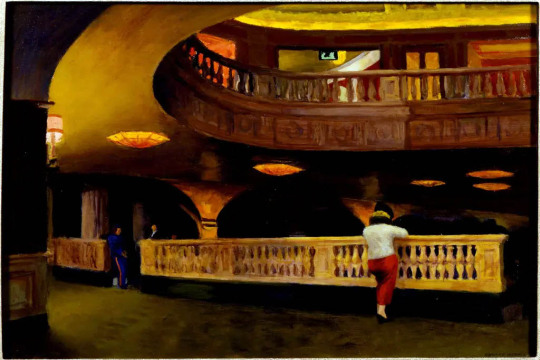
Edward Hopper, The Sheridan Theater, 1937. Oil on canvas.
This painting shows the voluptuous shell of glowing, orange-tinted space that is "The Sheridan Theater,” which depicts one of the Art Deco movie palaces that Hopper so loved to paint. The scene is inhabited by a lone woman who watches the screen standing at the back of the house, her chunky figure contradicting the flowing architecture.
A mouthwatering curiosity is what the viewer takes away from Edward Hopper’s painting “The Sheridan Theatre” (1937), the subject of a splendid little exhibition at the Newark Museum. The painting depicts a disquieting scene of a woman alone at the back of a movie theater, watched by two figures, one of them an usher. Is she waiting for friends, or has she simply arrived late? We don’t know, for her behavior doesn’t fit with any typical pattern of moviegoing.
—Roberta Smith in the NY Times
The pleasures of this painting are numerous, from the ambiguity of the central figure to the stylized, evocative architecture and graceful shifts of lighting in the balcony. It is one of Hopper’s best movie-theater paintings. …
A cinéaste, Hopper once remarked to a friend: “When I don’t feel in the mood for painting I go to the movies for a week or more. I go on a regular movie binge!” His favorite movie theater was the Sheridan in the West Village of Manhattan, not far from a townhouse on Washington Square where he and his wife and model, the artist Josephine Nivison, lived on the top floor for most of their lives. Calm, silent and luminous, “The Sheridan Theatre” … oozes strangeness.
—Benjamin Genocchio in the NY Times
#New York#NYC#vintage New York#1930s#Edward Hopper#painting#Sheridan Theater#realism#movie theater#theater#oil painting#Roberta Smith#Benjamin Genocchio#art criticism#art
76 notes
·
View notes
Photo
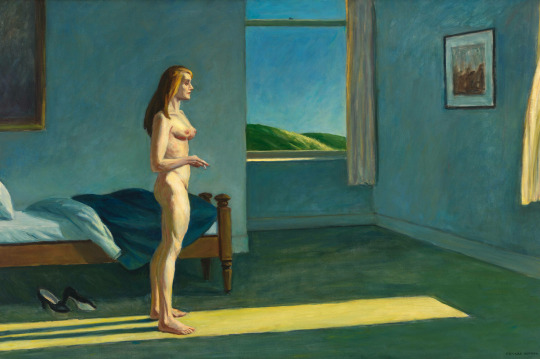
Edward Hopper
A Woman in the Sun 1961
As Edward Hopper matured he left more and more visual detail out of his paintings and focused on the psychological reality of his subjects. In A Woman in the Sun, a nude female stands in a shaft of raking light from a nearby window. The room has been reduced to its simplest architectural components. The few judicious details that remain—a pair of black pumps, the turned wood bedposts, and the vaguely delineated painting on the wall—only accentuate the barrenness of the scene and the figure. The voyeuristic, almost cinematic setting suggests a narrative, enticing the viewer to imagine the events that may have occurred prior to the scene we now view, and what will happen next. Hopper’s wife, Josephine Nivison Hopper, served as the model for this figure as she did for many of the women who appeared in his paintings. She was seventy-eight at the time of this painting, but Hopper transformed her, like the rest of the scene, according to his own internal vision rather than faithfully adhering to realistic detail
44 notes
·
View notes
Text

#ICYMI The new episode of Crossroads of Rockland History is now in the archive!
Listen to it here: https://soundcloud.com/cbsheridan/115-josephine-nivison-hopper-with-jennifer-patton-crossroads-of-rockland-history
Broadcast originally aired on Monday, May 18 at 9:30 am, on WRCR 1700 AM and WRCR.com
We turned our attention to the life and work of the artist Josephine Nivison Hopper.
Josephine Nivison was an accomplished artist by the time she started dating Edward Hopper in 1923, but the world knows very little about her. Jennifer Patton, executive director of the Edward Hopper House in Nyack, joined Clare Sheridan to discuss Josephine Nivison Hopper’s career before she met Edward Hopper, how she helped launch his career, and what happened to her life and work after they married in 1924.
About Jennifer Patton, EdD: Jennifer Patton was hired as the Edward Hopper House’s first full-time Executive Director through a workforce development grant in January 2016 and has overseen the expansion of the museum’s educational partnerships, public programming, and community outreach. Not only was the Edward Hopper House able to maintain her position, but the budget has grown by 25 percent since she was hired. Jennifer has worked as a museum educator in the field for twenty-five years; during that time, she received her doctorate in education from Teachers College, Columbia University, researching how museums can transform communities.
About the Edward Hopper House: Edward Hopper House gives new understanding and depth to an iconic American artist by preserving his family home and boyhood memorabilia and illuminating his sources of inspiration in Nyack through our collections, exhibition and programs. To learn more, go to www.edwardhopperhouse.org.
***
Crossroads of Rockland History, a program of the Historical Society of Rockland County, airs on the third Monday of each month at 9:30 am, right after the Steve and Jeff morning show, on WRCR radio 1700AM and www.WRCR.com. Join host Clare Sheridan as we explore, celebrate, and learn about our local history, with different topics and guest speakers every month.
The Historical Society of Rockland County is a nonprofit educational institution and principal repository for original documents and artifacts relating to Rockland County. Its headquarters are a four-acre site featuring a history museum and the 1832 Jacob Blauvelt House in New City, New York.
#Edward Hopper#women in art#Josephine Nivison Hopper#Edward Hopper House#Rockland History#Nyack History#feminsm#Artist Couples
0 notes
